Cisco Systems RTPRO0350 Wireless IP Phone User Manual 9971 rt901
Cisco Systems Inc Wireless IP Phone 9971 rt901
Contents
- 1. User Manual 1
- 2. User Manual 2
- 3. User Manual 3
- 4. User Manual 4
- 5. User Manual 5
User Manual 2
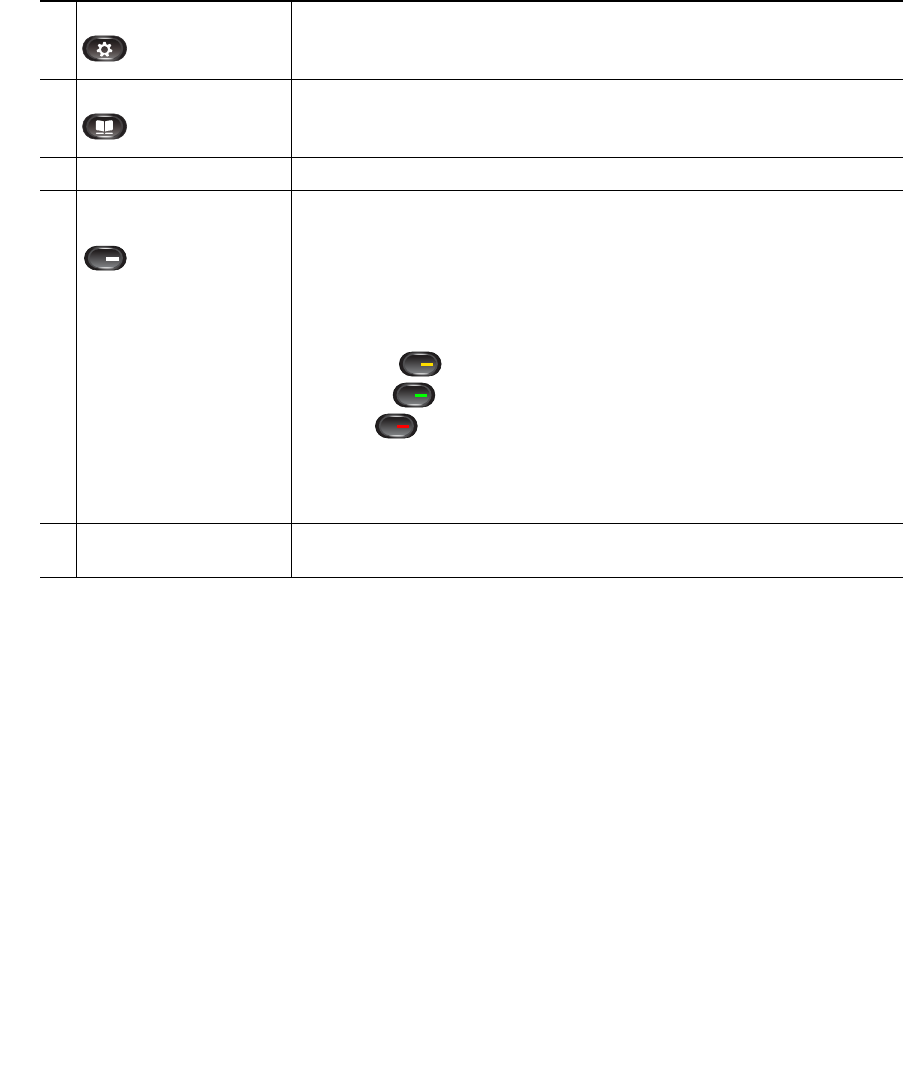
Your Phone
Cisco Unified IP Phone 8961, 9951, and 9971 User Guide for Cisco Unified Communications Manager 7.1(3) (SIP) 9
EFT DRAFT - CISCO CONFIDENTIAL
Phone Screen
How your system administrator sets up the phone determines what is displayed on your phone screen.
16 Applications button Opens/closes the Applications menu. Depending on how your system
administrator sets up the phone, use it to access applications such as
call history, preferences, and phone information.
17 Contacts button Opens/closes the Contacts menu. Depending on how your system
administrator sets up the phone, use it to access personal directory,
corporate directory, or call history.
18 Phone display Phone display that can be positioned to your preferred viewing angle.
19 Programmable feature
buttons
Programmable feature buttons that correspond to phone lines, speed
dials, and calling features.
Pressing a button for a phone line displays the active calls for that line.
If you have multiple lines, you might have an All Calls feature button
that displays a consolidated list of calls from all lines.
Color LEDs indicate the line state:
• Amber —Ringing call on this line
• Green —Active or held call on this line
• Red —Shared line in-use remotely
(The position of programmable feature buttons may be reversed with
that of session buttons on phones using a locale with a right-to-left
reading orientation, such as Hebrew and Arabic.)
20 Handset with light strip The handset light strip lights up to indicate a ringing call (flashing red)
or a new voice message (steady red).
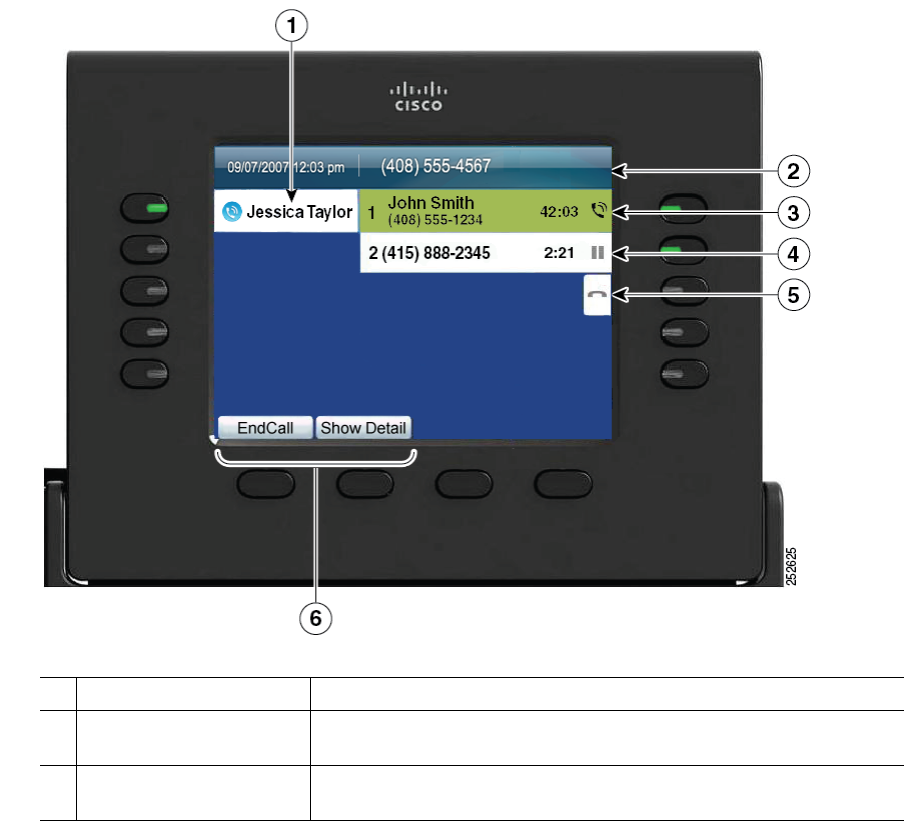
10 OL-19963-01
EFT DRAFT - CISCO CONFIDENTIAL
Phone with Single Line
1Line label Displays the line phone information.
2Header Displays the date and time, and information (such as phone number)
about the selected line.
3Session button label (for
connected call)
Displays information (such as phone number and duration) about a
connected call on the line.
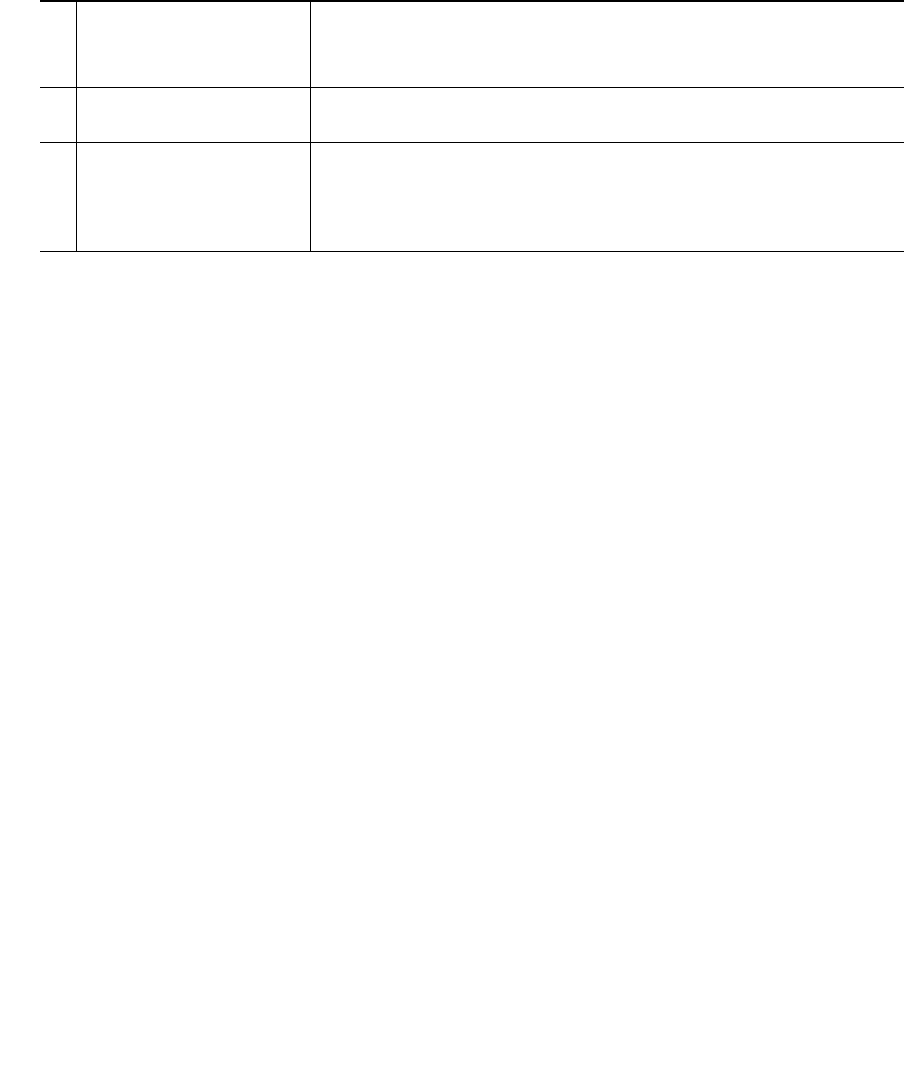
Your Phone
Cisco Unified IP Phone 8961, 9951, and 9971 User Guide for Cisco Unified Communications Manager 7.1(3) (SIP) 11
EFT DRAFT - CISCO CONFIDENTIAL
Phone with Multiple Lines
If you have multiple lines, it is highly recommended that the All Calls feature is enabled on your phone.
All Calls allows you to view all the calls on all lines at the same time. For more information, see your
system administrator.
4Session button label (for
held call)
Displays information (such as phone number and duration) about a
held call on the line.
Pressing the corresponding session button resumes the held call.
5New Call icon Indicates you can press the corresponding session button to make a
new call.
6Softkeys Softkey options for the selected (highlighted) call only.
If you select a different call (by pressing a feature button or the
Navigation pad, or by answering a ringing call), the softkey options
may change.
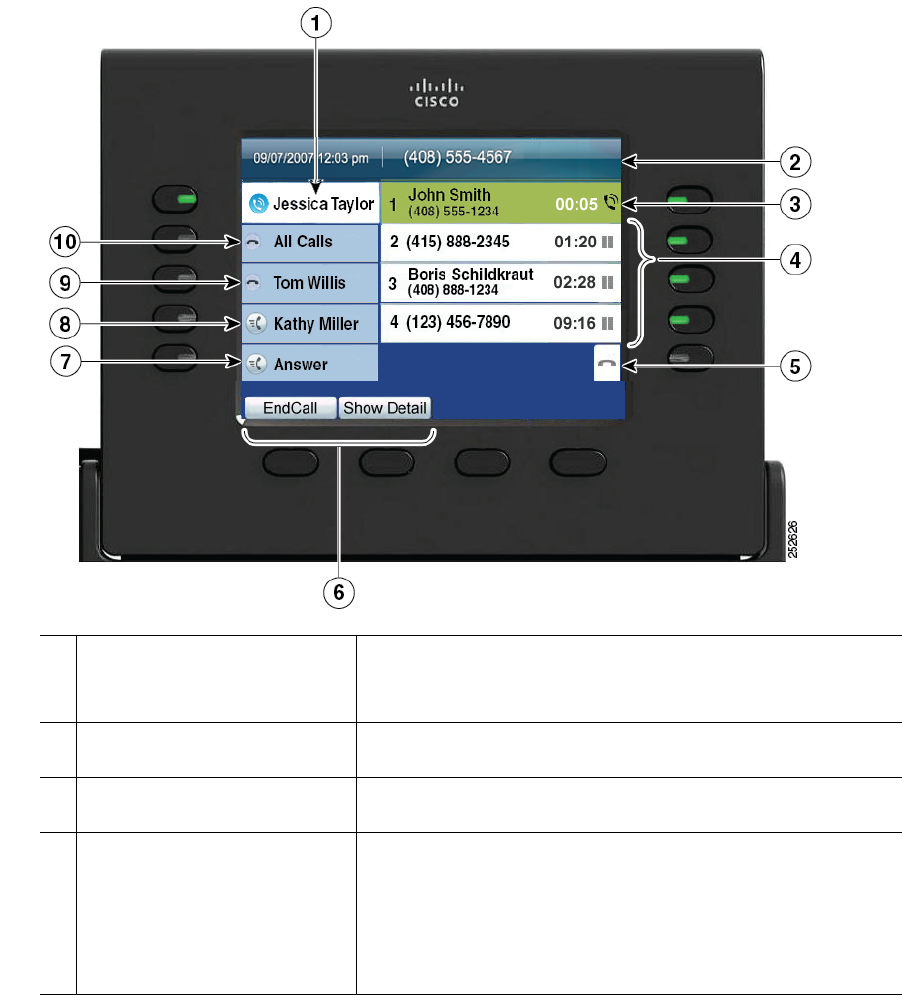
12 OL-19963-01
EFT DRAFT - CISCO CONFIDENTIAL
1Primary line label Displays the primary line phone information.
In this example, the blue icon (for Connected Call) indicates
this is the selected line.
2Header Displays the date and time, and information (such as phone
number) about the selected line.
3Session button label (for a
connected call)
Displays information (such as phone number and duration)
about a connected call on the line.
4Session button labels (for held
calls)
Display information (such as call status and duration) about
held calls associated with the selected line.
Calls are displayed on the right side of the phone screen from
the oldest (at the top) to the newest.
Pressing the session button next to a Held Call icon resumes the
held call for that session.
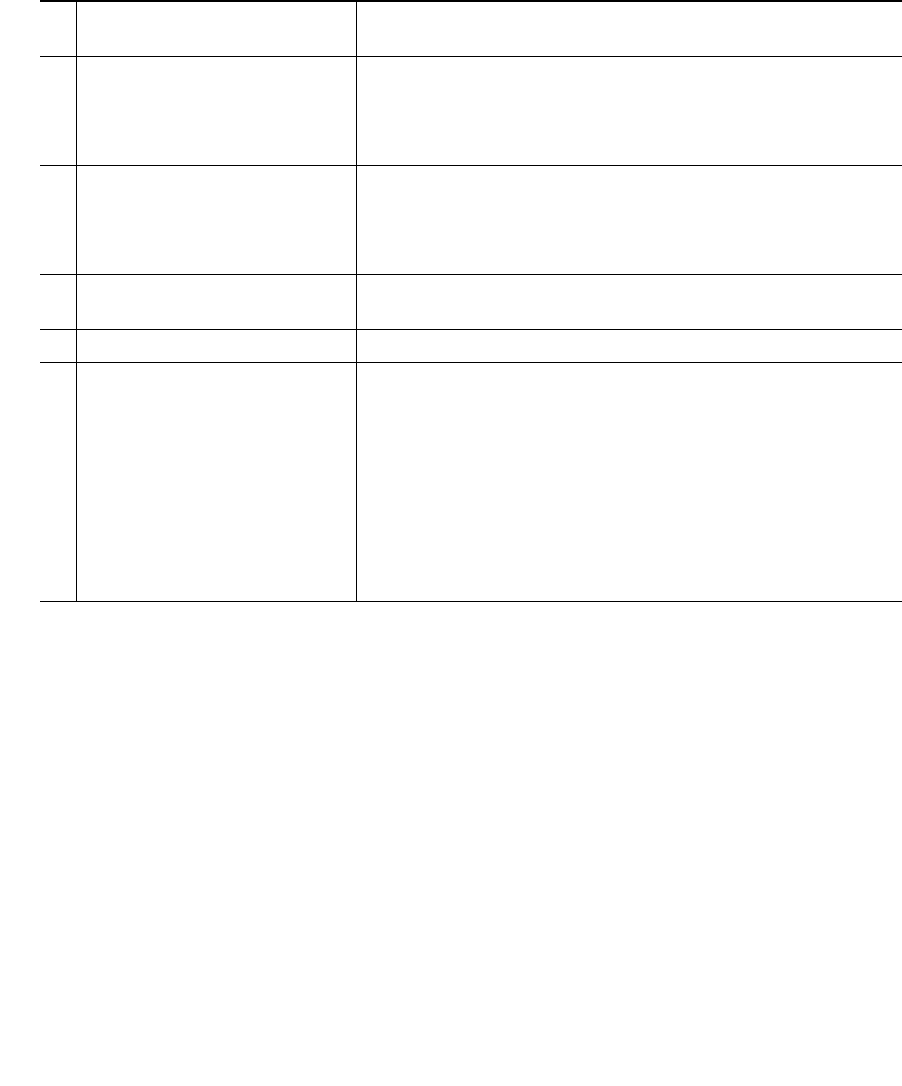
Your Phone
Cisco Unified IP Phone 8961, 9951, and 9971 User Guide for Cisco Unified Communications Manager 7.1(3) (SIP) 13
EFT DRAFT - CISCO CONFIDENTIAL
5New Call icon Indicates you can press the corresponding session button to
make a new call.
6Softkeys Softkey options for the selected (highlighted) call only.
If you select a different call (by pressing a feature button or the
Navigation pad, or by answering a ringing call), the softkey
options may change.
7Answer button label Displays if your system administrator has assigned the Answer
feature to the programmable feature button.
Pressing the corresponding button answers the oldest incoming
call.
8Speed-dial button label Displays if you assigned a speed dial to the programmable
feature button.
9Nonprimary line labels Displays the nonprimary line phone information.
10 All Calls button label Displays if the All Calls feature is enabled. Pressing the
corresponding button displays all calls on all lines.
Calls are displayed on the right side of the phone screen from
the oldest (at the top) to the newest.
Pressing the button once highlights (selects) the current call or
first call on the list. Pressing the button twice highlights the
header line, allowing you to make a new call.
Using the All Calls feature is highly recommended if you have
multiple lines on your phone.
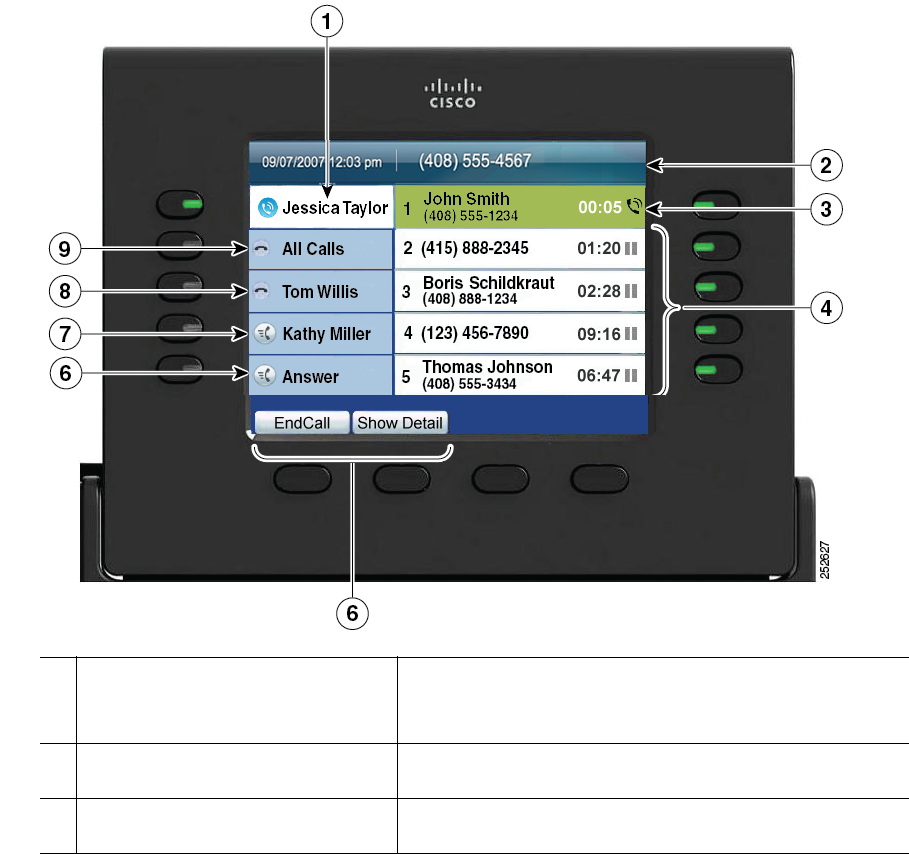
14 OL-19963-01
EFT DRAFT - CISCO CONFIDENTIAL
Phone with Answer Button
1Primary line label Displays the primary line phone information.
In this example, the blue icon (for Connected Call)
indicates this is the selected line.
2Header Displays the date and time, and information (such as phone
number) about the selected line.
3Session label (with Connected Call
icon)
Displays information (such as call status and duration)
about a connected call associated with the selected line.
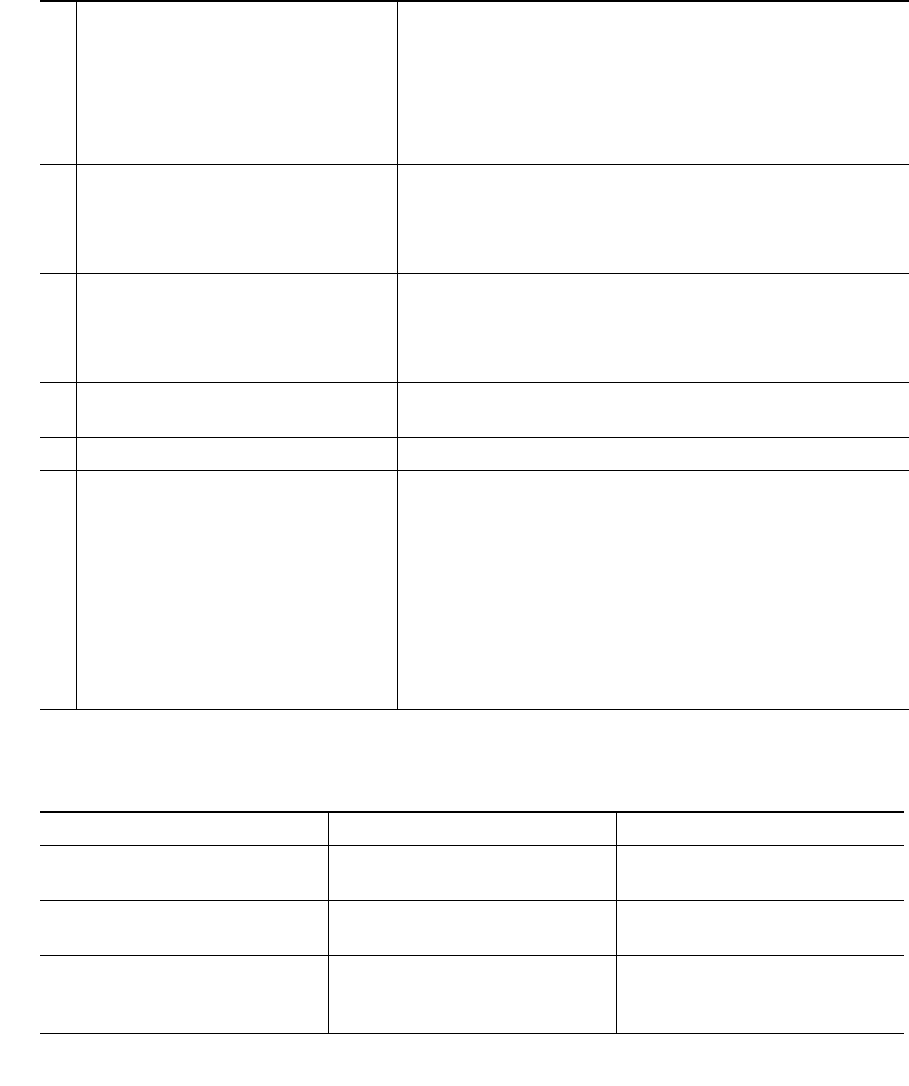
Your Phone
Cisco Unified IP Phone 8961, 9951, and 9971 User Guide for Cisco Unified Communications Manager 7.1(3) (SIP) 15
EFT DRAFT - CISCO CONFIDENTIAL
Phone Screen Navigation and Item Selection
4Session button labels (with Held
Call icons)
Display information (such as call status and duration)
about held calls associated with the selected line.
Calls are displayed on the right side of the phone screen
from the oldest (at the top) to the newest.
Pressing the session button next to a Held Call icon
resumes the held call for that session.
5Softkeys Softkey options for the selected (highlighted) call only.
If you select a different call (by pressing a feature button or
the Navigation pad, or by answering a ringing call), the
softkey options may change.
6Answer button label Displays if your system administrator has assigned the
Answer feature to the programmable feature button.
Pressing the corresponding button answers the oldest
incoming call.
7Speed-dial button label Displays if you assigned a speed dial to the programmable
feature button.
8Nonprimary line labels Displays the nonprimary line phone information.
9All Calls button label Displays if the All Calls feature is enabled. Pressing the
corresponding button displays all calls on all lines.
Calls are displayed on the right side of the phone screen
from the oldest (at the top) to the newest.
Pressing the button once highlights (selects) the current call
or first call on the list. Pressing the button twice highlights
the header line, allowing you to make a new call.
Using the All Calls feature is highly recommended if you
have multiple lines on your phone.
Task Action Example
Scroll to highlight an item. Press the Navigation pad. Highlight a call from the missed
call list.
Select an item by number. Press the corresponding number
on the keypad.
Press 2 to select the second item
in the Applications menu.
Select an item using the Select
button.
Press the Select button (at the
center of the Navigation pad).
Highlight the Preferences
application and press the Select
button.

16 OL-19963-01
EFT DRAFT - CISCO CONFIDENTIAL
Navigate to a submenu.
(A right arrow (>) next to the
menu item indicates there is a
submenu.)
Highlight the menu item and
press the item number on the
keypad.
Or press the down arrow on the
Navigation pad and then press
the Select button.
Highlight the Network Setup
menu, then press 1 to open the
submenu.
Select a line to use a calling
feature (when line is idle).
Press the feature (line) button.
Indicators of your line selection
include:
• The selected line is
displayed on the phone
screen header.
• The selected line is
highlighted.
• Color of the icon (on the
line label) changes to blue.
Press the line button, then press
the Forward All softkey to
forward calls on that line.
Select a line to use a calling
feature (when line has one or
more active calls).
Press the feature (line) button
twice.
Indicators of your line selection
include:
• The selected line is
displayed on the phone
screen header.
• The selected line is
highlighted.
• Color of the icon (on the
line label) changes to blue.
Press the line button twice, then
press the Forward All softkey to
forward calls on that line.
Task Action Example
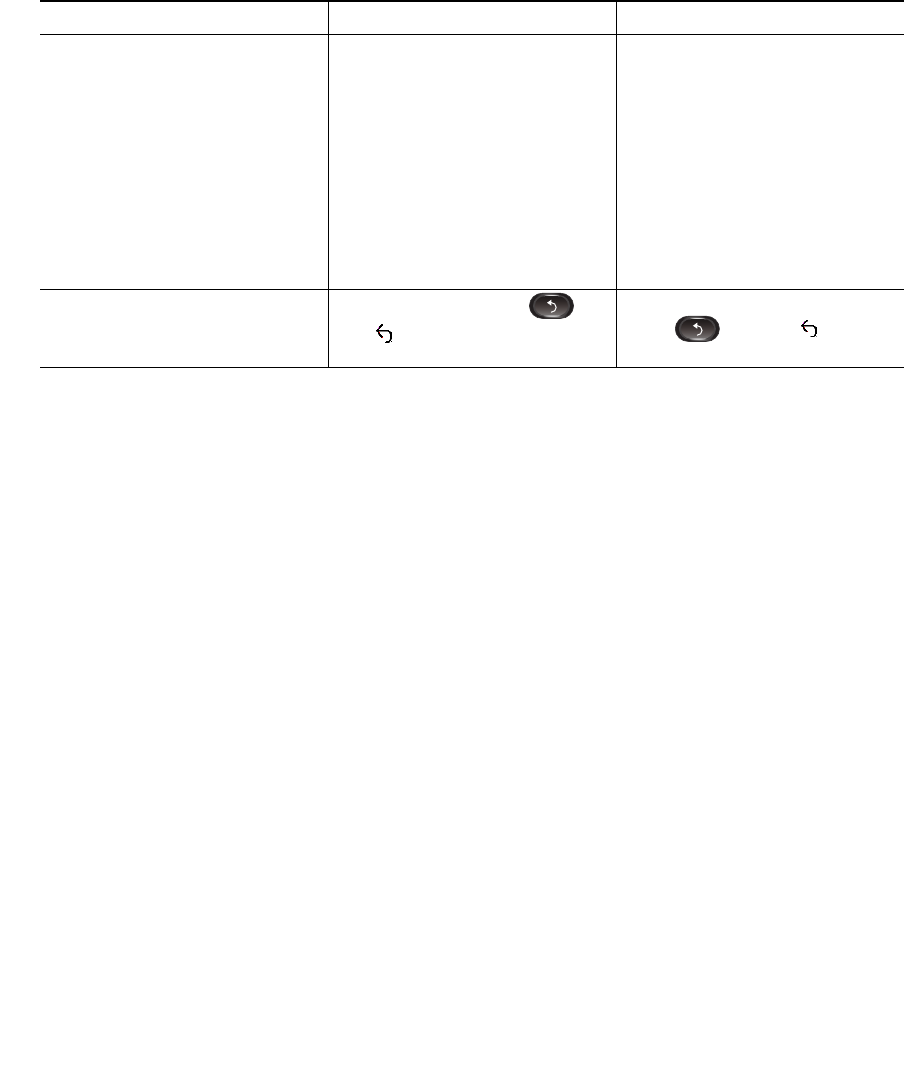
Your Phone
Cisco Unified IP Phone 8961, 9951, and 9971 User Guide for Cisco Unified Communications Manager 7.1(3) (SIP) 17
EFT DRAFT - CISCO CONFIDENTIAL
Power-Save Mode
Depending on how your system administrator sets up the phone, your phone display might go into
power-save mode (the phone screen appears blank and the Select button is lit white). To turn on the
phone display, press any button or pick up the handset.
Change the line view (while on a
call).
Select a different line (by
pressing the line feature button
or by scrolling and pressing the
Select button).
If you are on a call, changing the
line view does not end the call,
but it may disappear from view.
To see your current call session
again, select the line the call is
on.
While on a call, press a different
line button.
Call session information for the
newly selected line is displayed.
Call session information
previously displayed may
disappear from view.
Go back to the previous screen
or menu.
Press the Back button or
the softkey.
From the Preferences menu,
press or the
softkey.
Task Action Example
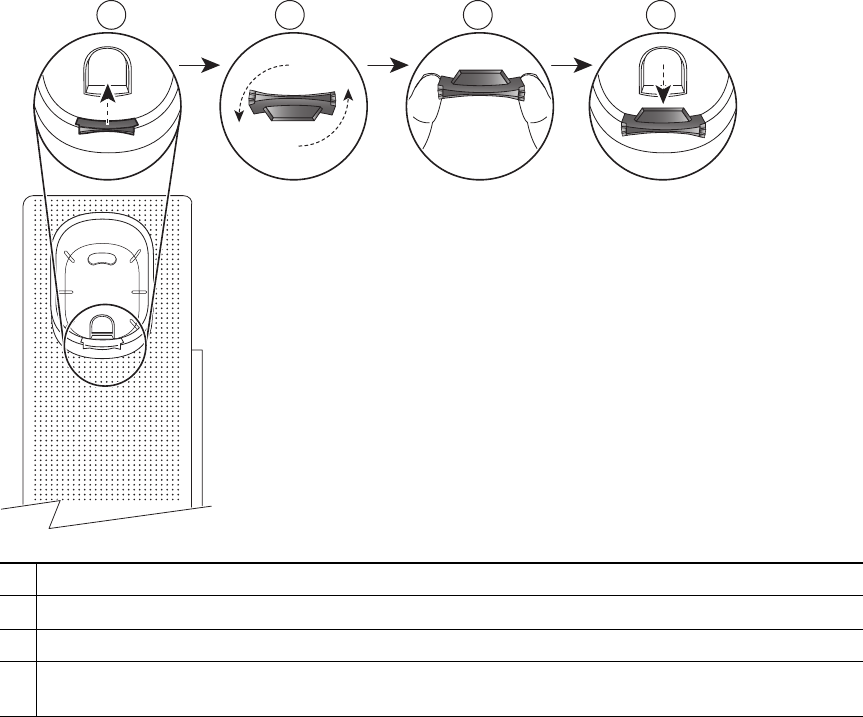
18 OL-19963-01
EFT DRAFT - CISCO CONFIDENTIAL
Handset Rest
Your system administrator may have mounted your phone on a wall. With a wall-mounted phone, you
might need to adjust the handset rest to ensure that the receiver will not slip out of the cradle.
1Remove handset from the cradle and pull the plastic tab from the handset rest.
2Rotate the tab 180 degrees.
3Hold the tab between two fingers, with the corner notches facing you.
4Line up the tab with the slot in the cradle, and press the tab evenly into the slot. An extension
protrudes from the top of the rotated tab. Return the handset to the handset rest.
21 3
275943
4

Your Phone
Cisco Unified IP Phone 8961, 9951, and 9971 User Guide for Cisco Unified Communications Manager 7.1(3) (SIP) 19
EFT DRAFT - CISCO CONFIDENTIAL
Cisco Unified IP Phone 9951
The Cisco Unified IP Phone 9951 provides these features:
• Phone connections
• Footstand
• Phone display viewing angle
• Buttons and hardware
• Phone screen
• Power-save mode
• Handset rest
Phone Connections
For your phone to work, it must be connected to the corporate IP telephony network. Your system
administrator can help you connect your phone.
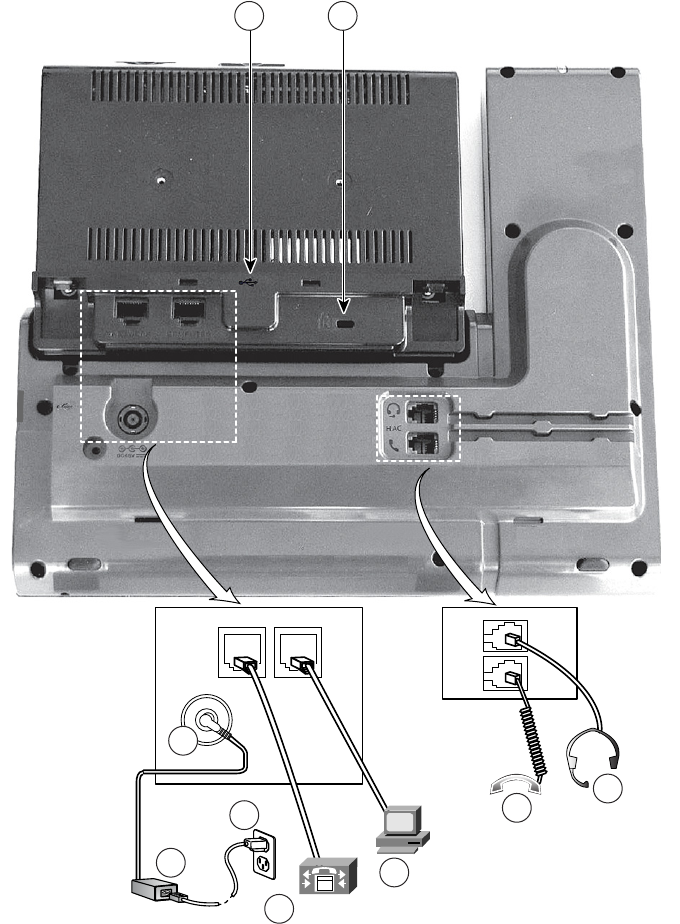
20 OL-19963-01
EFT DRAFT - CISCO CONFIDENTIAL
193117
8 9
2
3
4
5
6
7
1
ComputerNetwork
ComputerNetwork
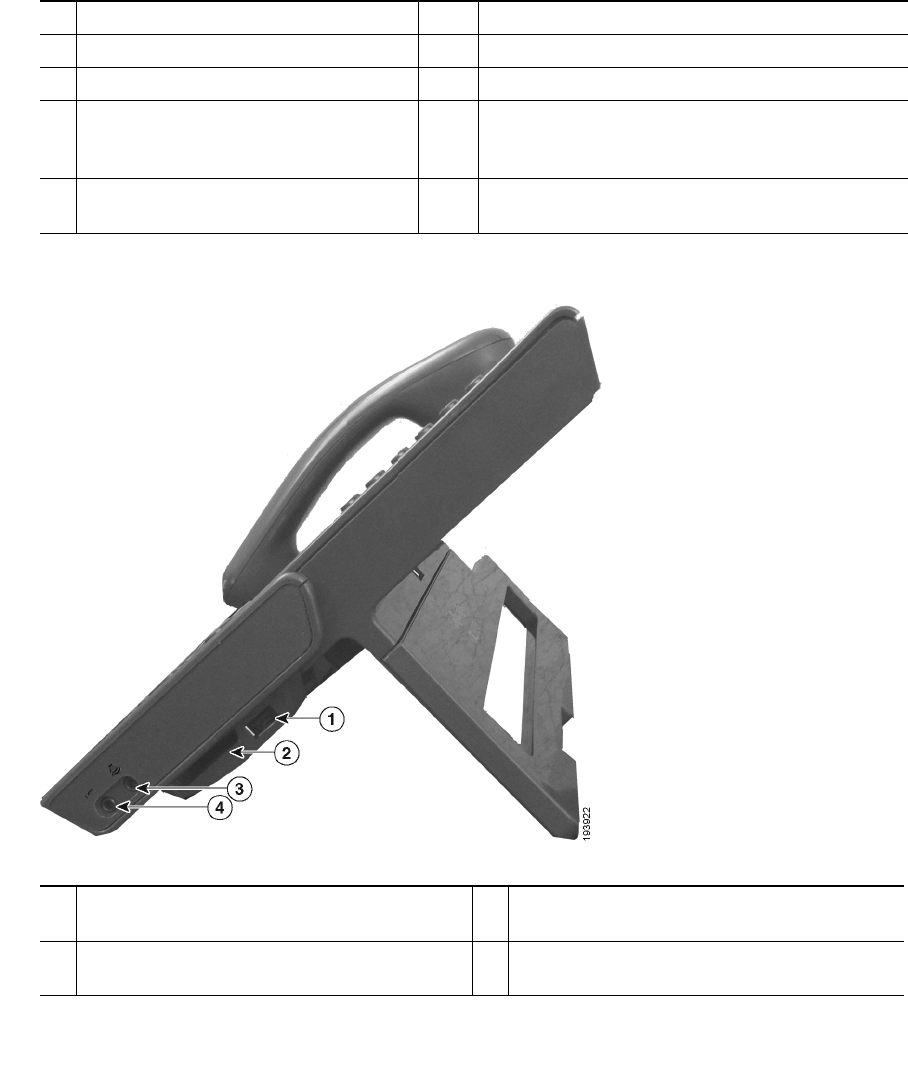
Your Phone
Cisco Unified IP Phone 8961, 9951, and 9971 User Guide for Cisco Unified Communications Manager 7.1(3) (SIP) 21
EFT DRAFT - CISCO CONFIDENTIAL
1DC adaptor port (DC48V) 6Handset connection
2AC-to-DC power supply (optional) 7Analog headset connection (optional)
3AC power wall plug (optional) 8USB port
4Network port connection
(10/100/1000 SW) with IEEE 802.3af
power enabled
9Anti-theft security lock connector (lock optional)
5Computer port (10/100/1000 PC)
connection
1USB port 3Speaker port for output to optional external
speakers
2Cisco Unified IP Color Key Expansion
Module connector
4Microphone port for input from optional
external microphone
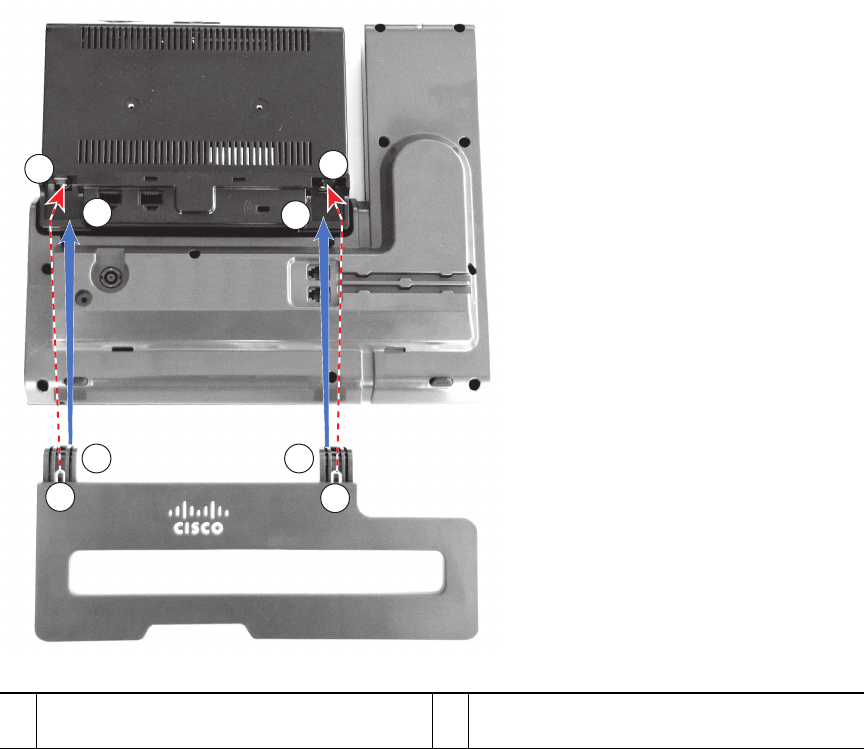
22 OL-19963-01
EFT DRAFT - CISCO CONFIDENTIAL
Footstand
If your phone is placed on a table or desk, connect the footstand to the back of the phone.
1Insert the curved connectors into the lower
slots.
2Lift the footstand until the connectors snap
into the upper slots.
1
1
22
22
1
1
193118
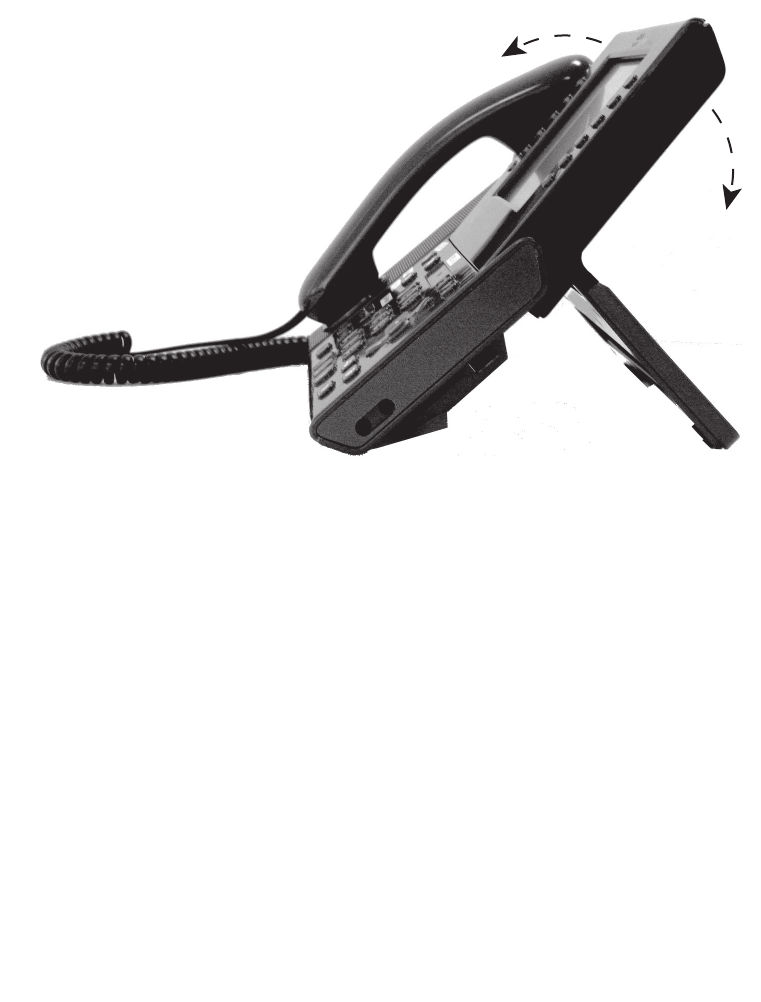
Your Phone
Cisco Unified IP Phone 8961, 9951, and 9971 User Guide for Cisco Unified Communications Manager 7.1(3) (SIP) 23
EFT DRAFT - CISCO CONFIDENTIAL
Phone Display Viewing Angle
The phone display viewing angle can be adjusted according to your preference.
Buttons and Hardware
Your phone provides quick access to your phone lines, features, and call sessions. Use the feature
buttons (on the left) to view calls on a line or access features such as speed dial or All Calls. Use the
call session buttons (on the right) to perform tasks such as making a call, answering a call, or resuming
a held call.
193119
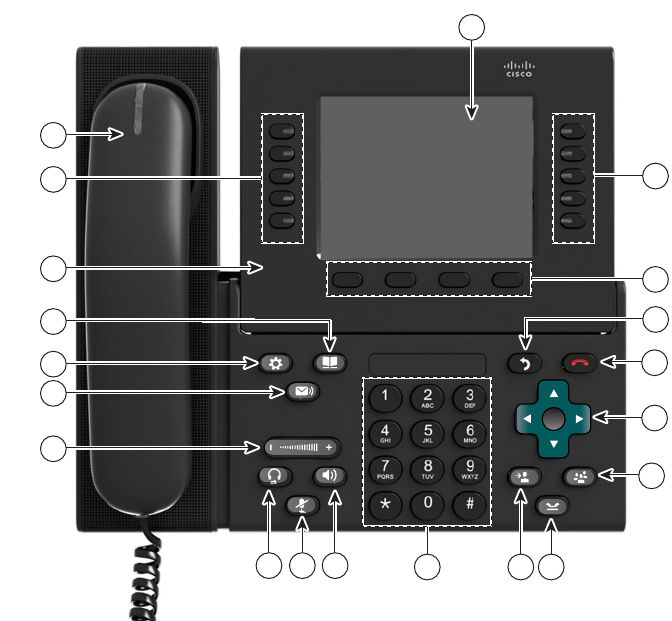
24 OL-19963-01
EFT DRAFT - CISCO CONFIDENTIAL
1
8
12 1113 10 9
14
18
20
19
15
16
17
5
6
7
2
3
4
194674
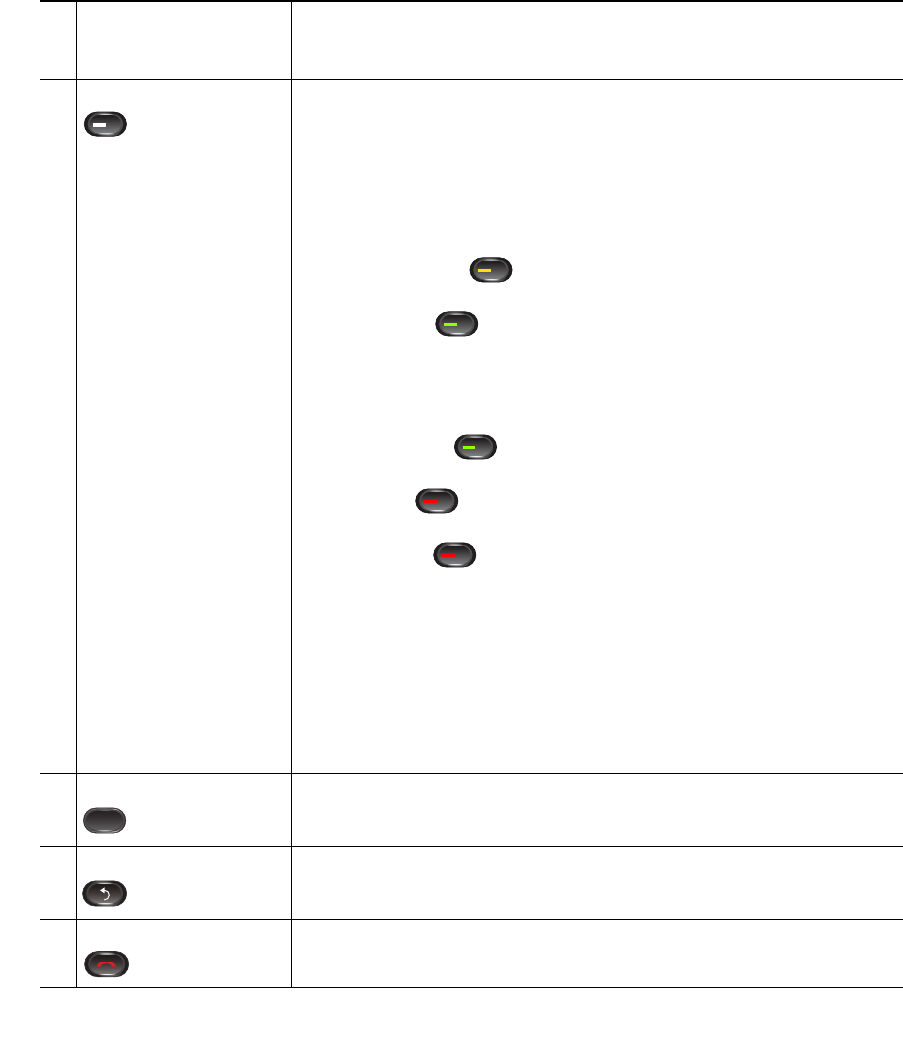
Your Phone
Cisco Unified IP Phone 8961, 9951, and 9971 User Guide for Cisco Unified Communications Manager 7.1(3) (SIP) 25
EFT DRAFT - CISCO CONFIDENTIAL
1Phone screen Shows information about your phone, including directory number, call
information (for example caller ID, icons for an active call or call on
hold) and available softkeys.
2Session buttons Each represents a call session and takes the default action for that
session. For example, pressing the session button for a ringing call
answers the call, while pressing the session button for a held call
resumes the call.
Color LEDs reflect the call state. LEDs can flash (blink on and off
rapidly), pulse (alternately dim and brighten), or appear solid (glow
without interruption).
• Flashing amber —Ringing call. Pressing this button answers
the call.
• Solid green —May be a connected call or an outgoing call
that is not yet connected. If the call is connected, pressing this
button displays the call details or the participants of a conference
call. If the call is not yet connected, pressing this button ends the
call.
• Pulsing green —Held call. Pressing this button resumes the
held call.
• Solid red —Shared line in-use remotely. Pressing this button
allows you to barge in on the call (if Barge is enabled).
• Pulsing red —Shared line call put on hold remotely. Pressing
this button resumes the held call.
Icons next to the session buttons indicate an action for that session. For
example, pressing the session button with a Missed Calls icon displays
your missed calls, and pressing the session button with a Voicemail
icon accesses your voice messaging system.
(The position of session buttons may be reversed with that of
programmable feature buttons on phones using a locale with a
right-to-left reading orientation, such as Hebrew and Arabic.)
3Softkey buttons Allow you to access the softkey options displayed on your phone
screen.
4Back button Returns to the previous screen or menu.
5Release button Ends a connected call or session.
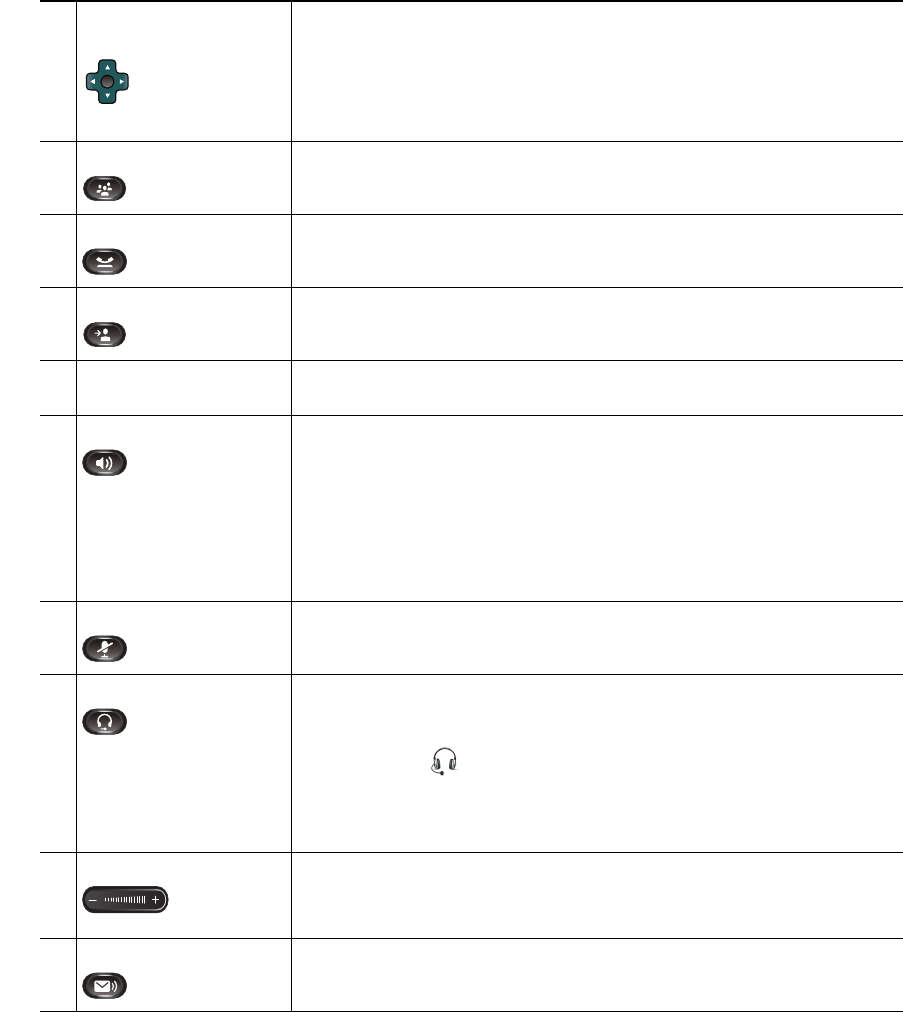
26 OL-19963-01
EFT DRAFT - CISCO CONFIDENTIAL
6Navigation pad and
Select button
The four-way Navigation pad allows you to scroll through menus,
highlight items, and move within a text input field.
The Select button (center of the Navigation pad) allows you to select a
highlighted item.
The Select button is lit (white) when the phone is in power-save mode.
7Conference button Creates a conference call.
8Hold button Places a connected call on hold.
9Transfer button Transfers a call.
10 Keypad Allows you to dial phone numbers, enter letters, and choose menu
items (by entering the item number).
11 Speakerphone button Selects the speakerphone as the default audio path and initiates a new
call, picks up an incoming call, or ends a call. During a call, the button
is lit green.
The speakerphone audio path does not change until a new default
audio path is selected (for example, by picking up the handset).
If external speakers are connected, the Speakerphone button selects
them as the default audio path.
12 Mute button Toggles the microphone on or off during a call. When the microphone
is muted, the button is lit red.
13 Headset button Selects the wired headset as the default audio path and initiates a new
call, picks up an incoming call, or ends a call. During a call, the button
is lit green.
A headset icon in the phone screen header line indicates the
headset is the default audio path. This audio path does not change until
a new default audio path is selected (for example, by picking up the
handset).
14 Volume button Controls the handset, headset, and speakerphone volume (off-hook)
and the ringer volume (on-hook).
Silences the ringer on the phone if an incoming call is ringing.
15 Messages button Auto-dials your voicemail system (varies by system).
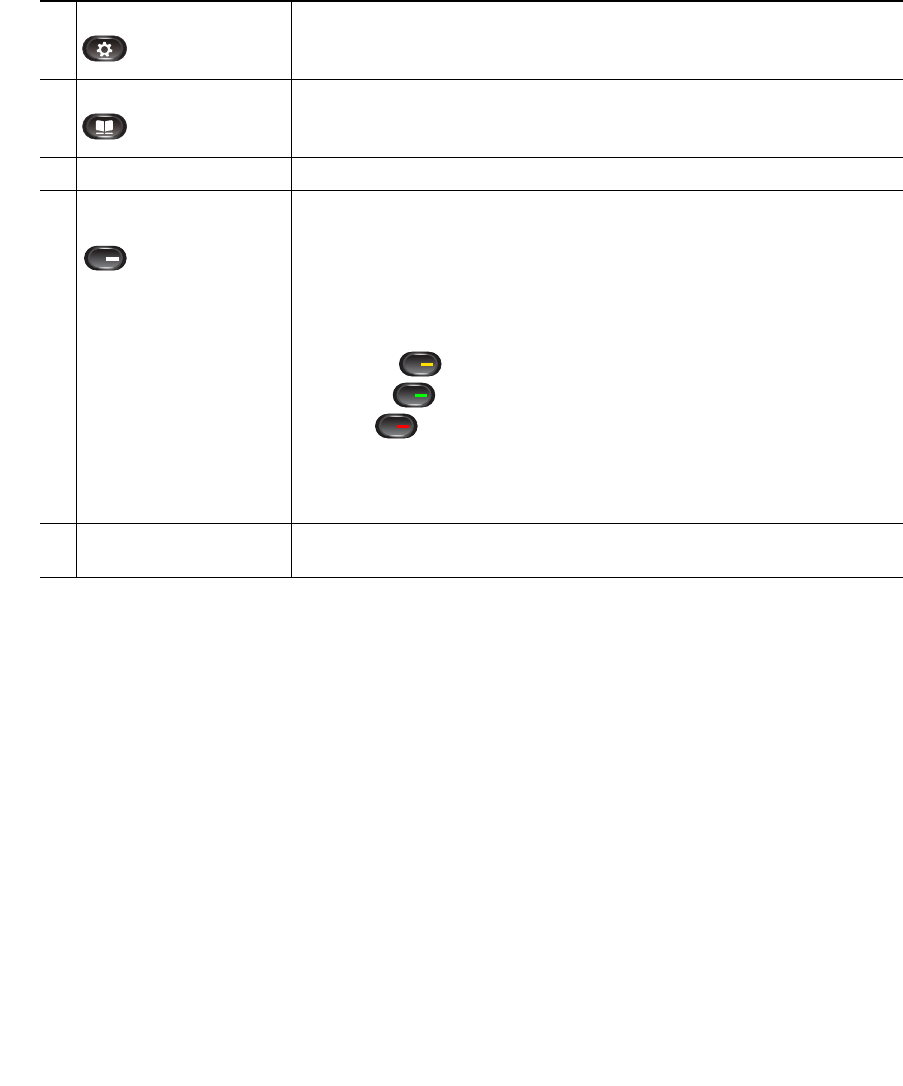
Your Phone
Cisco Unified IP Phone 8961, 9951, and 9971 User Guide for Cisco Unified Communications Manager 7.1(3) (SIP) 27
EFT DRAFT - CISCO CONFIDENTIAL
Phone Screen
How your system administrator sets up the phone determines what is displayed on your phone screen.
16 Applications button Opens/closes the Applications menu. Depending on how your system
administrator sets up the phone, use it to access applications such as
call history, preferences, and phone information.
17 Contacts button Opens/closes the Contacts menu. Depending on how your system
administrator sets up the phone, use it to access personal contacts,
corporate directory, or call history.
18 Phone display Phone display that can be positioned to your preferred viewing angle.
19 Programmable feature
buttons
Programmable feature buttons that correspond to phone lines, speed
dials, and calling features.
Pressing a button for a phone line displays the active calls for that line.
If you have multiple lines, you might have an All Calls feature button
that displays a consolidated list of calls from all lines.
Color LEDs indicate the line state:
• Amber —Ringing call on this line
• Green —Active or held call on this line
• Red —Shared line in-use remotely
(The position of programmable feature buttons may be reversed with
that of session buttons on phones using a locale with a right-to-left
reading orientation, such as Hebrew and Arabic.)
20 Handset with light strip The handset light strip lights up to indicate a ringing call (flashing red)
or a new voice message (steady red).
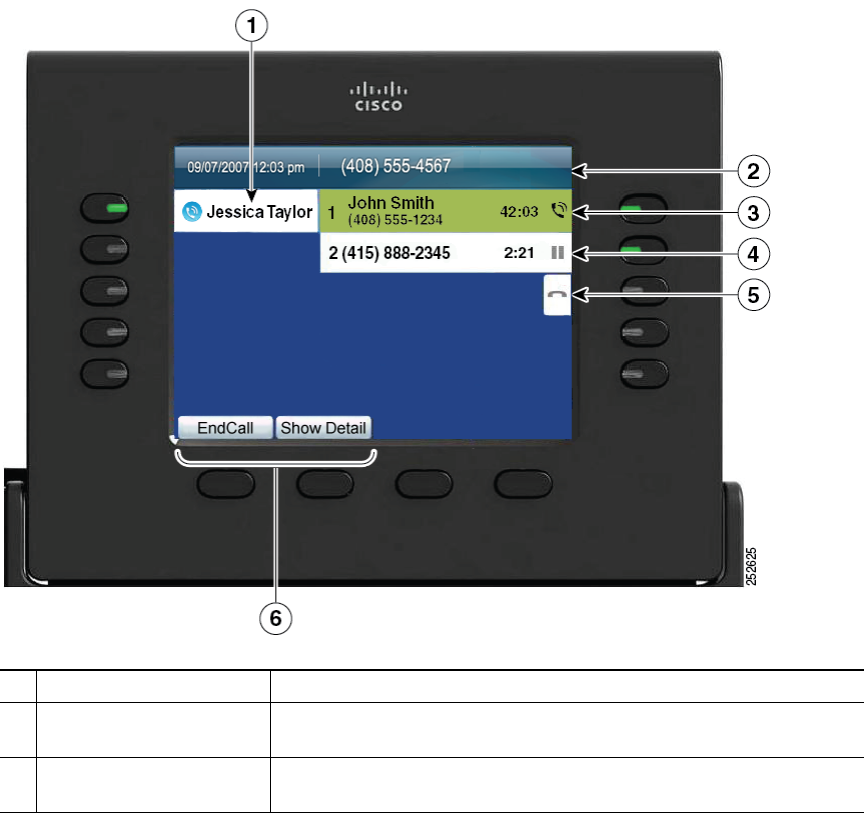
28 OL-19963-01
EFT DRAFT - CISCO CONFIDENTIAL
Phone with Single Line
1Line label Displays the line phone information.
2Header Displays the date and time, and information (such as phone number)
about the selected line.
3Session label (for
connected call)
Displays information (such as phone number and duration) about a
connected call on the line.
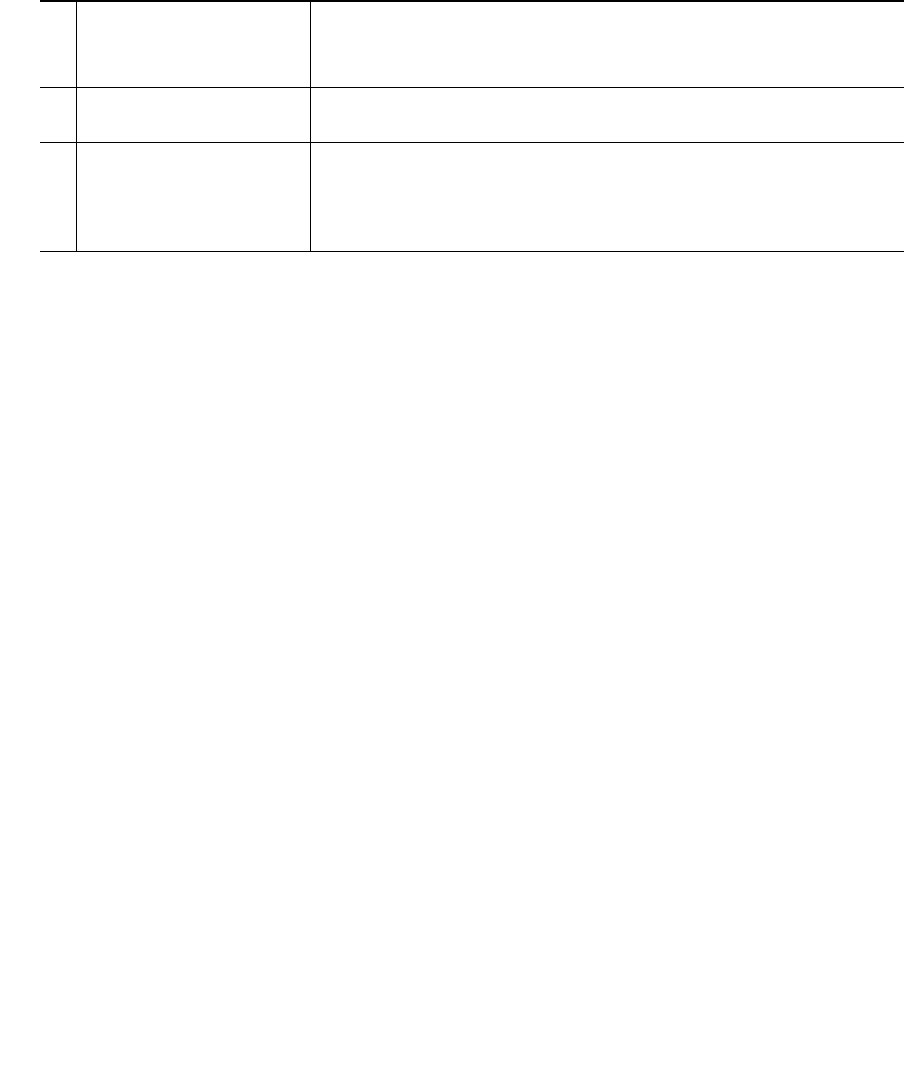
Your Phone
Cisco Unified IP Phone 8961, 9951, and 9971 User Guide for Cisco Unified Communications Manager 7.1(3) (SIP) 29
EFT DRAFT - CISCO CONFIDENTIAL
Phone with Multiple Lines
If you have multiple lines, it is highly recommended that the All Calls feature is enabled on your phone.
All Calls allows you to view all the calls on all lines at the same time. For more information, see your
system administrator.
4Session button label (for
held call)
Displays information (such as phone number and duration) about a
held call on the line.
Pressing the corresponding session button resumes the held call.
5New Call icon Indicates you can press the corresponding session button to make a
new call.
6Softkeys Softkey options for the selected (highlighted) call only.
If you select a different call (by pressing a feature button or the
Navigation pad, or by answering a ringing call), the softkey options
may change.
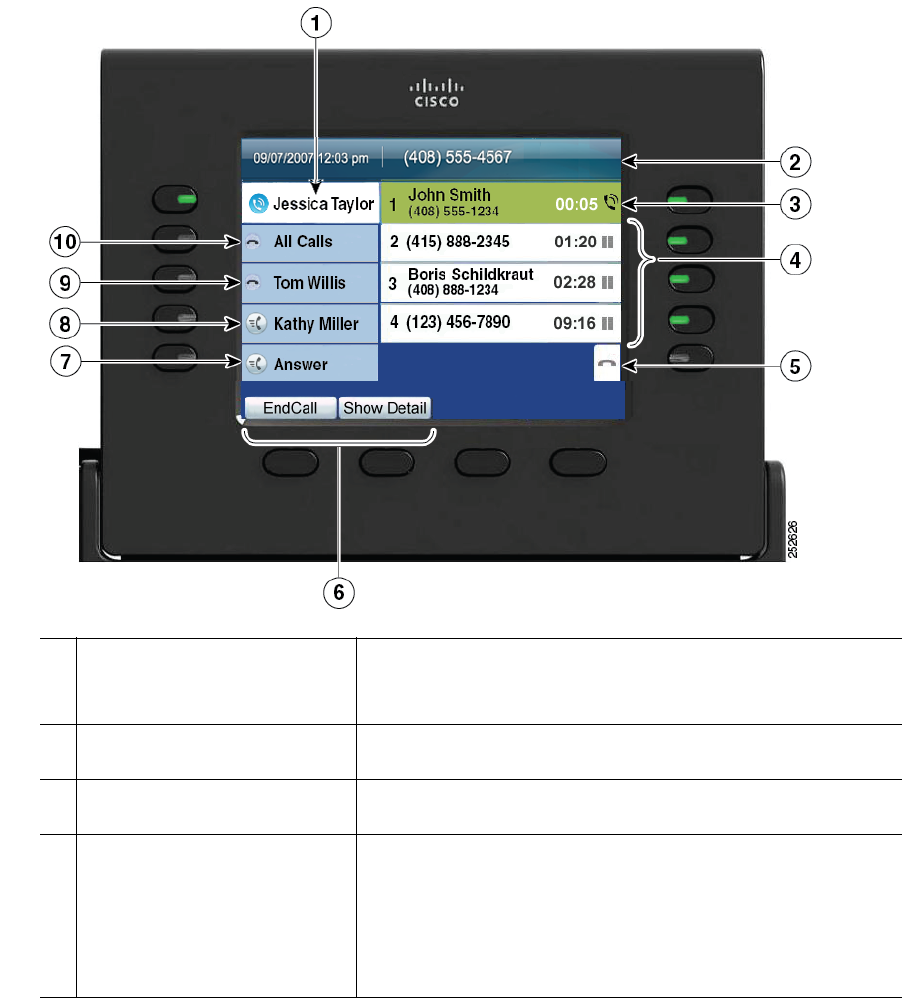
30 OL-19963-01
EFT DRAFT - CISCO CONFIDENTIAL
1Primary line label Displays the primary line phone information.
In this example, the blue icon (for Connected Call) indicates
this is the selected line.
2Header Displays the date and time, and information (such as phone
number) about the selected line.
3Session label (for a connected
call)
Displays information (such as phone number and duration)
about a connected call on the line.
4Session button labels (for held
calls)
Display information (such as call status and duration) about
held calls associated with the selected line.
Calls are displayed on the right side of the phone screen in
order of the oldest (at the top) to the newest.
Pressing the session button next to a Held Call icon resumes the
held call for that session.
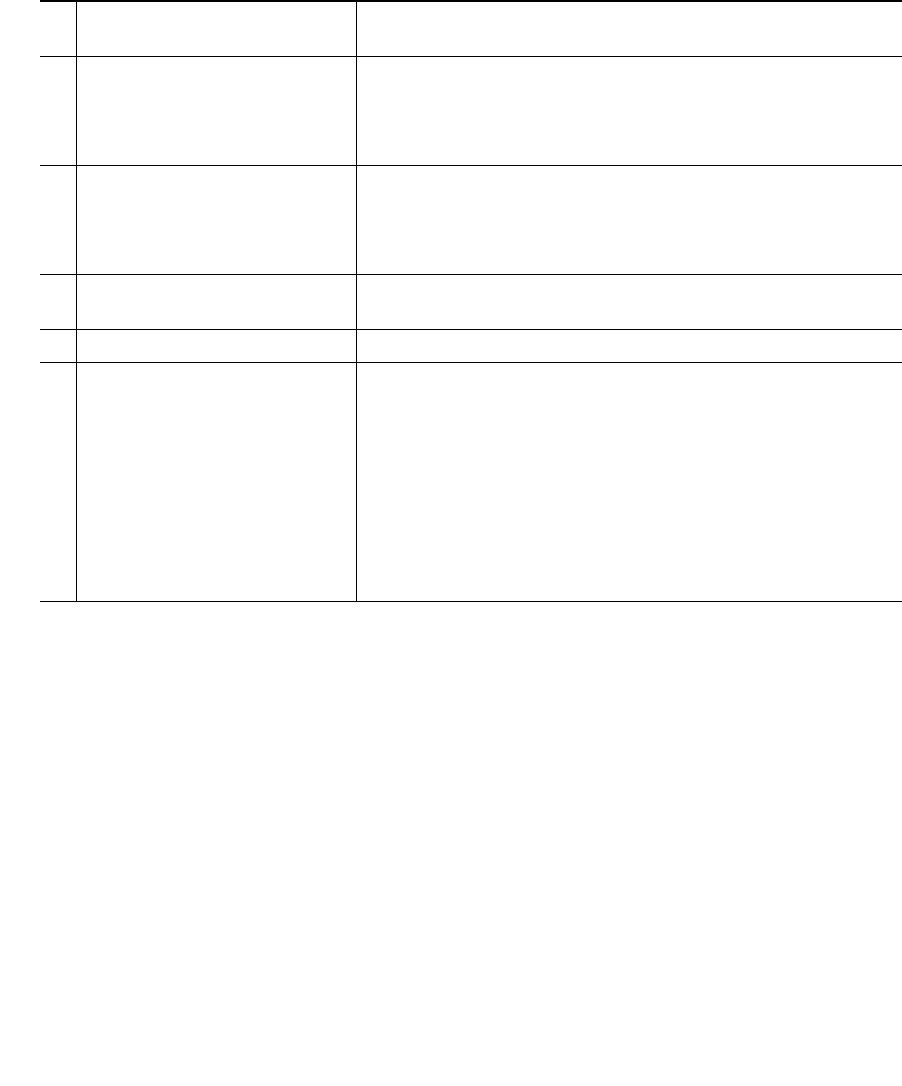
Your Phone
Cisco Unified IP Phone 8961, 9951, and 9971 User Guide for Cisco Unified Communications Manager 7.1(3) (SIP) 31
EFT DRAFT - CISCO CONFIDENTIAL
5New Call icon Indicates you can press the corresponding session button to
make a new call.
6Softkeys Softkey options for the selected (highlighted) call only.
If you select a different call (by pressing a feature button or the
Navigation pad, or by answering a ringing call), the softkey
options may change.
7Answer button label Displays if your system administrator has assigned the Answer
feature to the programmable feature button.
Pressing the corresponding button answers the oldest incoming
call.
8Speed-dial button label Displays if you assigned a speed dial to the programmable
feature button.
9Nonprimary line labels Displays the nonprimary line phone information.
10 All Calls button label Displays if the All Calls feature is enabled. Pressing the
corresponding button displays all calls on all lines.
Calls are displayed on the right side of the phone screen from
the oldest (at the top) to the newest.
Pressing the button once highlights (selects) the current call or
first call on the list. Pressing the button twice highlights the
header line, allowing you to make a new call.
Using the All Calls feature is highly recommended if you have
multiple lines on your phone.
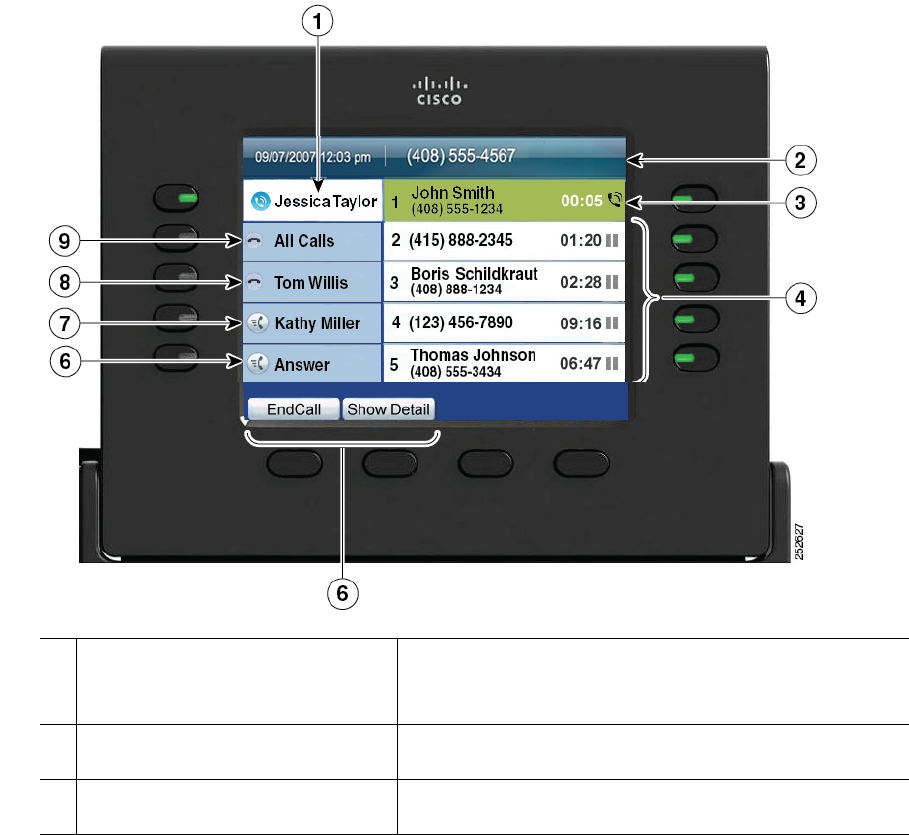
32 OL-19963-01
EFT DRAFT - CISCO CONFIDENTIAL
Phone with Answer Button
1Primary line label Displays the primary line phone information.
In this example, the blue icon (for Connected Call)
indicates this is the selected line.
2Header Displays the date and time, and information (such as phone
number) about the selected line.
3Session label (with Connected Call
icon)
Displays information (such as call status and duration)
about a connected call associated with the selected line.
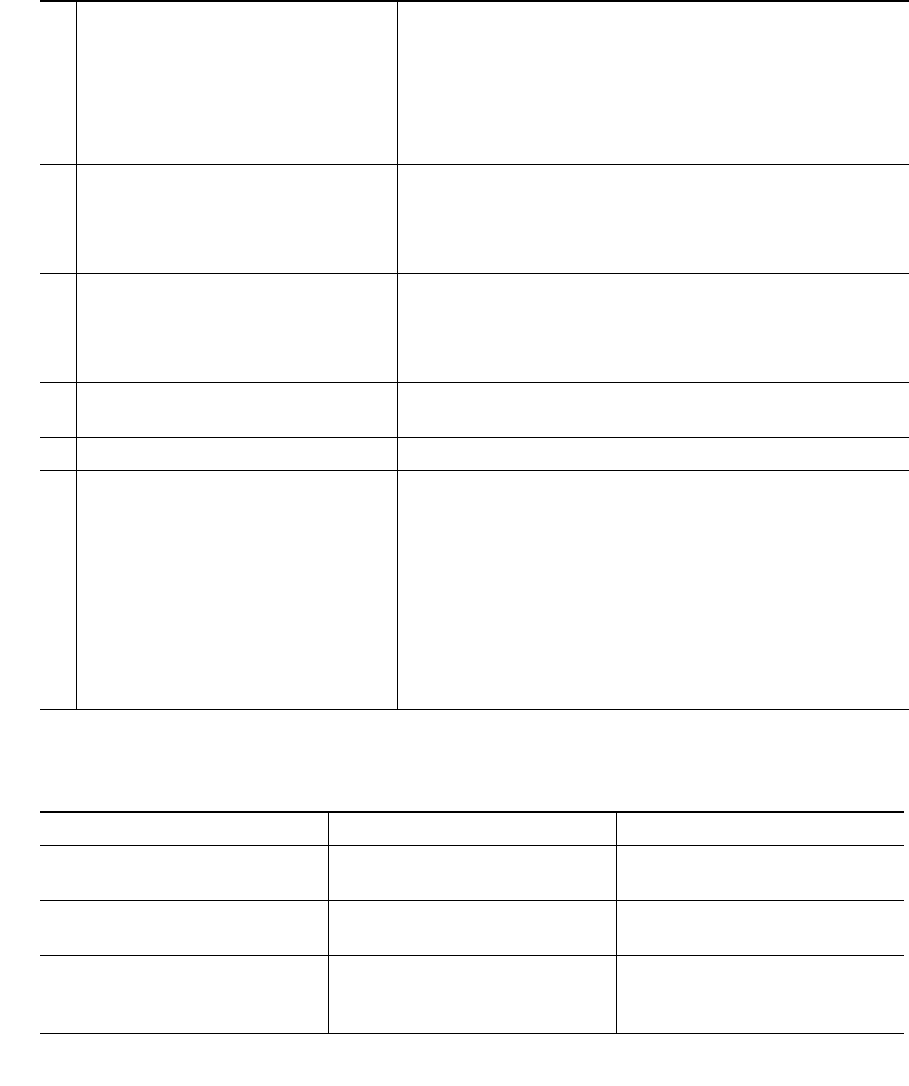
Your Phone
Cisco Unified IP Phone 8961, 9951, and 9971 User Guide for Cisco Unified Communications Manager 7.1(3) (SIP) 33
EFT DRAFT - CISCO CONFIDENTIAL
Phone Screen Navigation and Item Selection
4Session button labels (with Held
Call icons)
Display information (such as call status and duration)
about held calls associated with the selected line.
Calls are displayed on the right side of the phone screen
from the oldest (at the top) to the newest.
Pressing the session button next to a Held Call icon
resumes the held call for that session.
5Softkeys Softkey options for the selected (highlighted) call only.
If you select a different call (by pressing a feature button or
the Navigation pad, or by answering a ringing call), the
softkey options may change.
6Answer button label Displays if your system administrator has assigned the
Answer feature to the programmable feature button.
Pressing the corresponding button answers the oldest
incoming call.
7Speed-dial button label Displays if you assigned a speed dial to the programmable
feature button.
8Nonprimary line labels Displays the nonprimary line phone information.
9All Calls button label Displays if the All Calls feature is enabled. Pressing the
corresponding button displays all calls on all lines.
Calls are displayed on the right side of the phone screen
from the oldest (at the top) to the newest.
Pressing the button once highlights (selects) the current call
or first call on the list. Pressing the button twice highlights
the header line, allowing you to make a new call.
Using the All Calls feature is highly recommended if you
have multiple lines on your phone.
Task Action Example
Scroll to highlight an item. Press the Navigation pad. Highlight a call from the missed
call list.
Select an item by number. Press the corresponding number
on the keypad.
Press 2 to select the second item
in the Applications menu.
Select an item using the Select
button.
Press the Select button (at the
center of the Navigation pad).
Highlight the Preferences
application and press the Select
button.

34 OL-19963-01
EFT DRAFT - CISCO CONFIDENTIAL
Navigate to a submenu.
(A right arrow (>) next to the
menu item indicates there is a
submenu.)
Highlight the menu item and
press the item number on the
keypad.
Or press the down arrow on the
Navigation pad and then press
the Select button.
Highlight the Network Setup
menu, then press 1 to open the
submenu.
Select a line to use a calling
feature (when line is idle).
Press the feature (line) button.
Indicators of your line selection
include:
• The selected line is
displayed on the phone
screen header.
• The selected line is
highlighted.
• Color of the icon (on the
line label) changes to blue.
Press the line button, then press
the Forward All softkey to
forward calls on that line.
Select a line to use a calling
feature (when line has one or
more active calls).
Press the feature (line) button
twice.
Indicators of your line selection
include:
• The selected line is
displayed on the phone
screen header.
• The selected line is
highlighted.
• Color of the icon (on the
line label) changes to blue.
Press the line button twice, then
press the Forward All softkey to
forward calls on that line.
Task Action Example
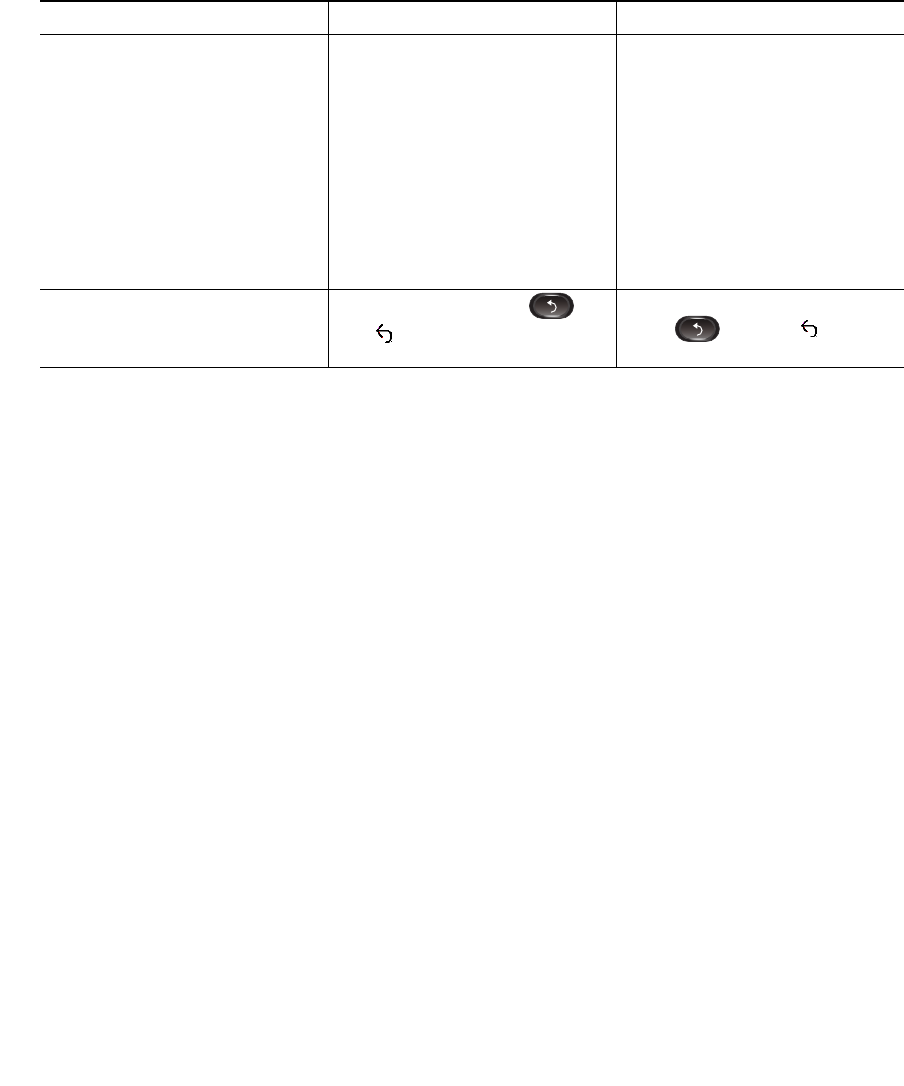
Your Phone
Cisco Unified IP Phone 8961, 9951, and 9971 User Guide for Cisco Unified Communications Manager 7.1(3) (SIP) 35
EFT DRAFT - CISCO CONFIDENTIAL
Power-Save Mode
Depending on how your system administrator sets up the phone, your phone display might go into
power-save mode (the phone screen appears blank and the Select button is lit white). To turn on the
phone display, press any button or pick up the handset.
Change the line view (while on a
call).
Select a different line (by
pressing the line button or
scrolling and pressing the Select
button).
If you are on a call, changing the
line view does not end the call,
but it may disappear from view.
To see your current call session
again, select the line the call is
on.
While on a call, press a different
line button.
Call session information for the
newly selected line is displayed.
Call session information
previously displayed may
disappear from view.
Go back to the previous screen
or menu.
Press the Back button or
the softkey.
From the Preferences menu,
press or the
softkey.
Task Action Example
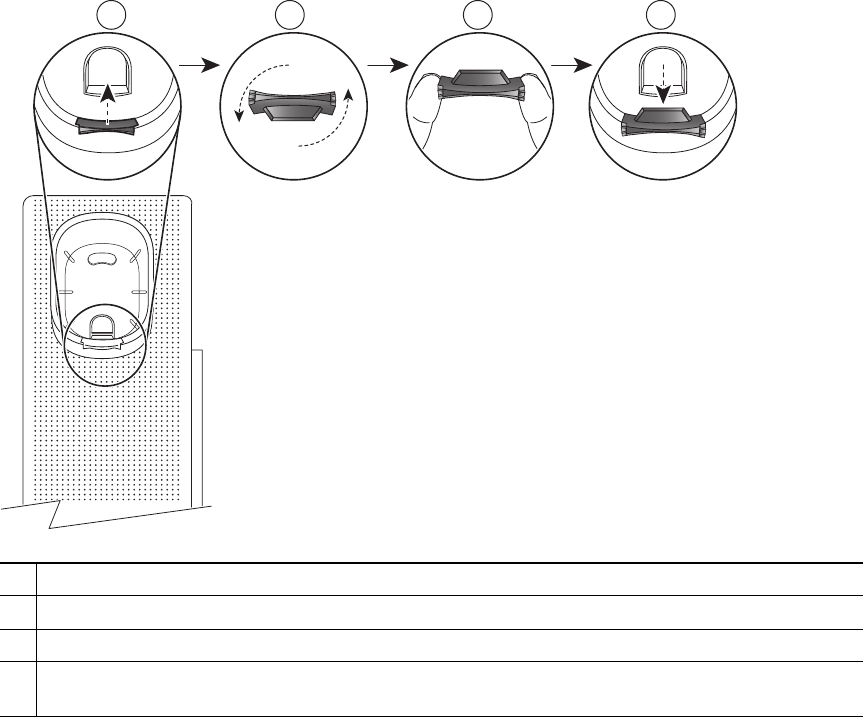
36 OL-19963-01
EFT DRAFT - CISCO CONFIDENTIAL
Handset Rest
Your system administrator may have mounted your phone on a wall. With a wall-mounted phone, you
might need to adjust the handset rest to ensure that the receiver will not slip out of the cradle.
1Remove handset from the cradle and pull the plastic tab from the handset rest.
2Rotate the tab 180 degrees.
3Hold the tab between two fingers, with the corner notches facing you.
4Line up the tab with the slot in the cradle, and press the tab evenly into the slot. An extension
protrudes from the top of the rotated tab. Return the handset to the handset rest.
21 3
275943
4

Your Phone
Cisco Unified IP Phone 8961, 9951, and 9971 User Guide for Cisco Unified Communications Manager 7.1(3) (SIP) 37
EFT DRAFT - CISCO CONFIDENTIAL
Cisco Unified IP Phone 9971
The Cisco Unified IP Phone 9971 provides these features:
• Phone connections
• Footstand
• Phone display viewing angle
• Buttons and hardware
• Phone screen
• Power-save mode
• Phone display cleaning
• Handset rest
Phone Connections
For your phone to work, it must be connected to the corporate IP telephony network. Your system
administrator can help you connect your phone.
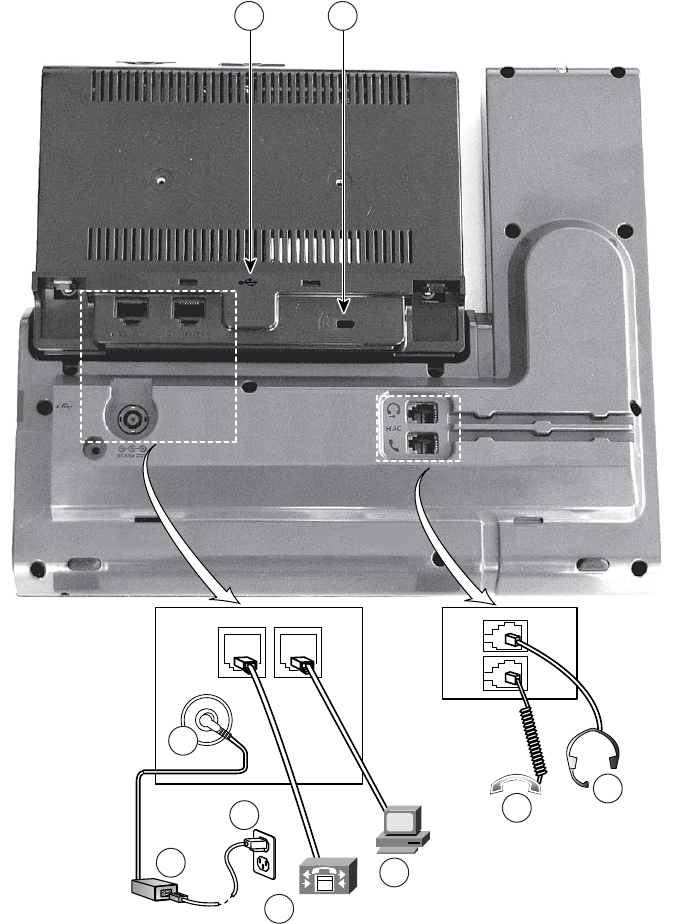
38 OL-19963-01
EFT DRAFT - CISCO CONFIDENTIAL
193117
8 9
2
3
4
5
6
7
1
ComputerNetwork
ComputerNetwork
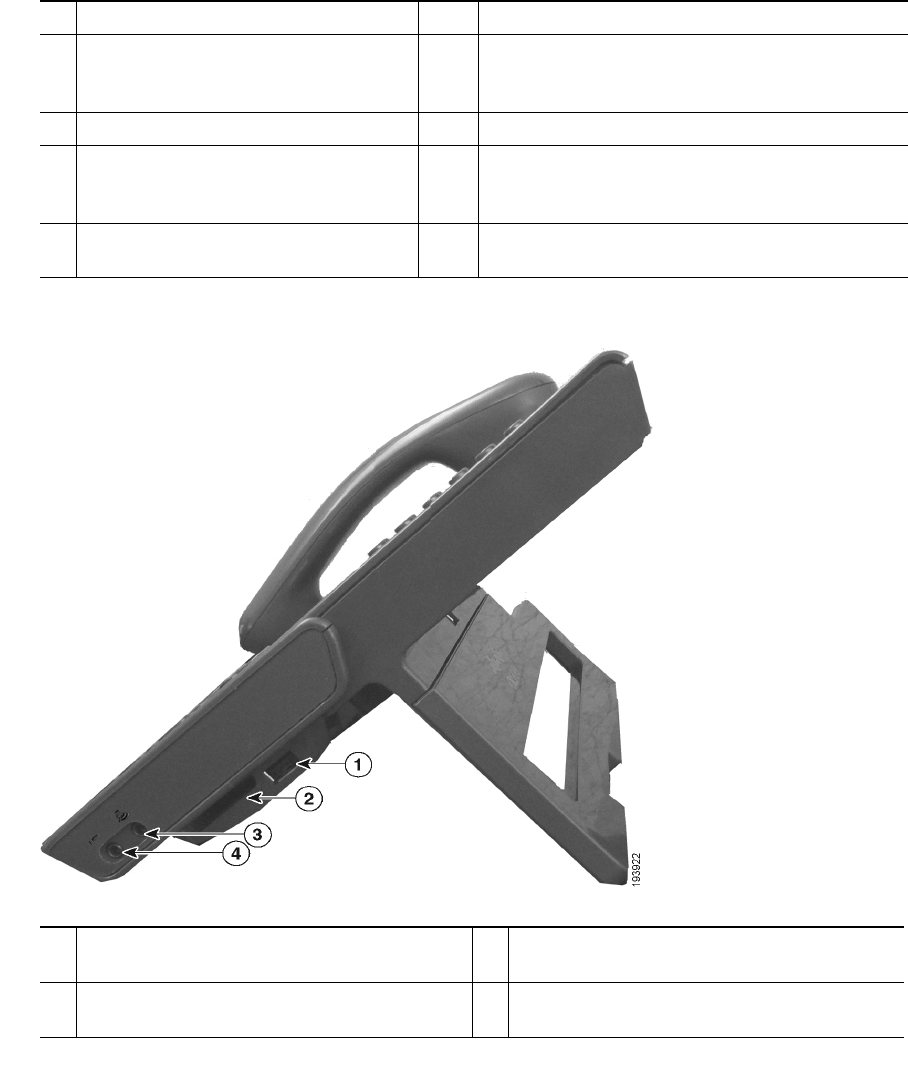
Your Phone
Cisco Unified IP Phone 8961, 9951, and 9971 User Guide for Cisco Unified Communications Manager 7.1(3) (SIP) 39
EFT DRAFT - CISCO CONFIDENTIAL
1DC adaptor port (DC48V) 6Handset connection
2AC-to-DC power supply (optional for
the network port connection but
required for a wifi connection)
7Analog headset connection (optional)
3AC power wall plug (optional) 8USB port
4Network port connection
(10/100/1000 SW) with IEEE 802.3af
and IEEE 802.3at power enabled
9Anti-theft security lock connector (lock optional)
5Computer port (10/100/1000 PC)
connection
1USB port 3Speaker port for output to optional external
speakers
2Cisco Unified IP Color Key Expansion
Module connector
4Microphone port for input from optional
external microphone
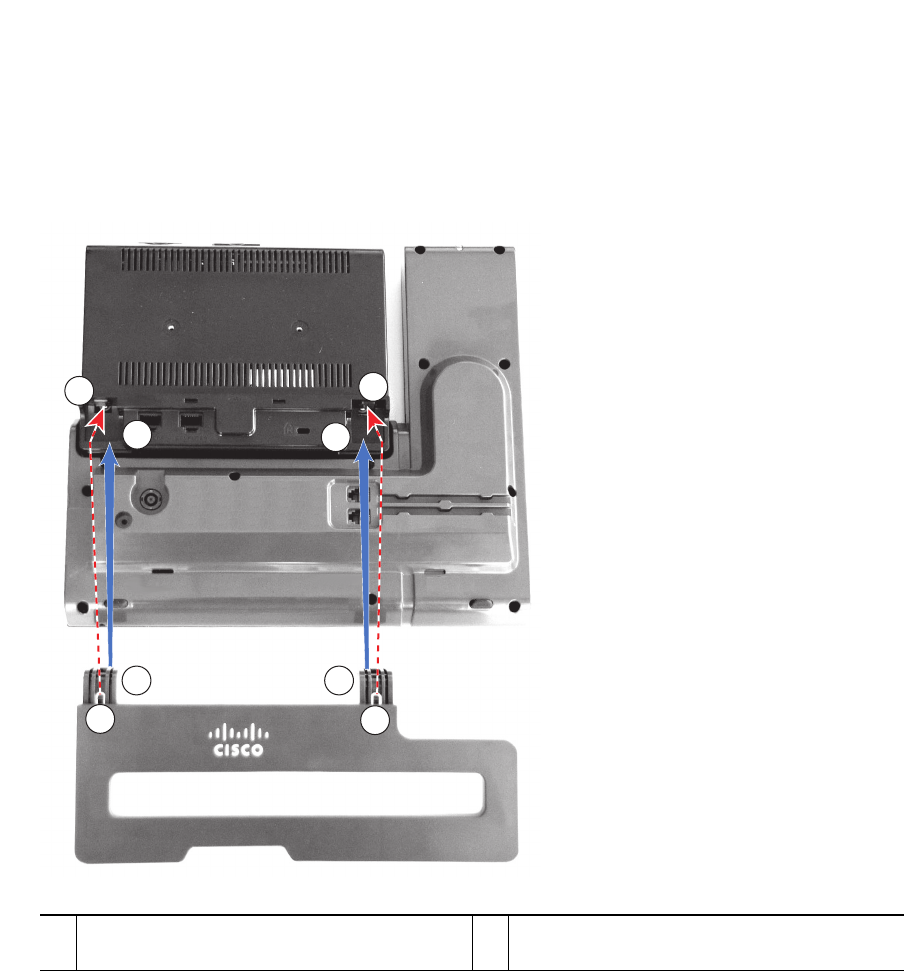
40 OL-19963-01
EFT DRAFT - CISCO CONFIDENTIAL
Wireless Connection
Your phone can be connected to a wireless network using 802.11a or 802.11b/g, but the connection
must be set up by your system administrator. For more information, see your system administrator.
Footstand
If your phone is placed on a table or desk, connect the footstand to the back of the phone.
1Insert the curved connectors into the lower
slots.
2Lift the footstand until the connectors snap
into the upper slots.
1
1
22
22
1
1
193118
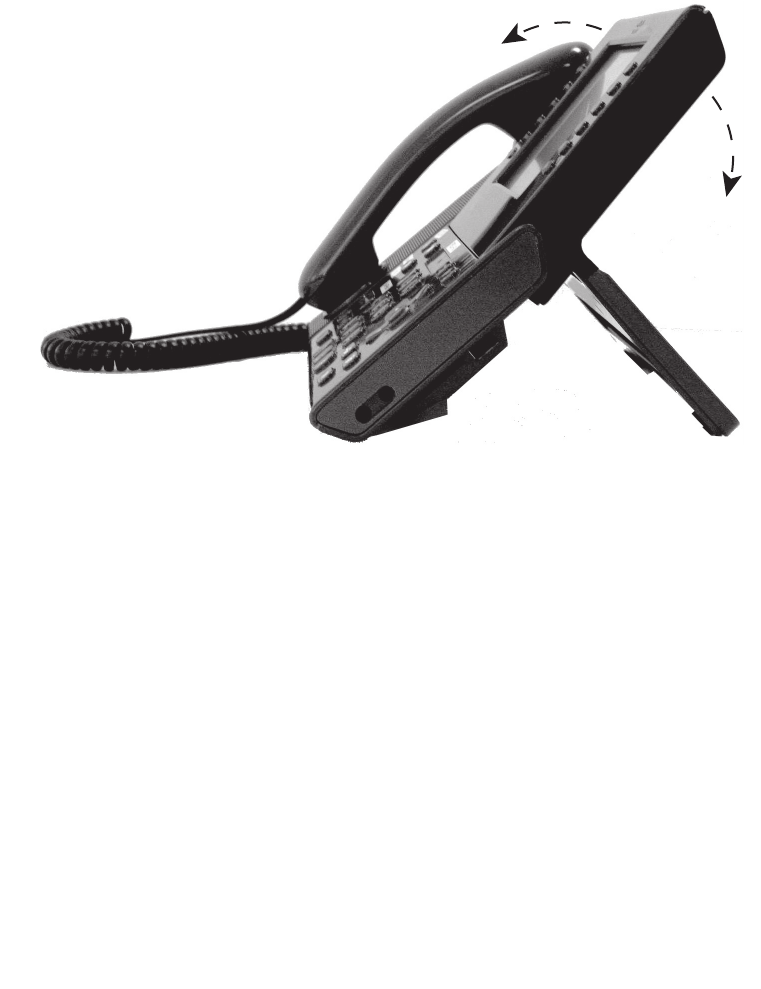
Your Phone
Cisco Unified IP Phone 8961, 9951, and 9971 User Guide for Cisco Unified Communications Manager 7.1(3) (SIP) 41
EFT DRAFT - CISCO CONFIDENTIAL
Phone Display Viewing Angle
The phone display viewing angle can be adjusted according to your preference.
Buttons and Hardware
Your phone provides quick access to your phone lines, features, and call sessions. Use the feature
buttons (on the left) to view calls on a line or access features such as speed dial or All Calls. Use the
call session buttons (on the right) to perform tasks such as making a call, answering a call, or resuming
a held call.
193119
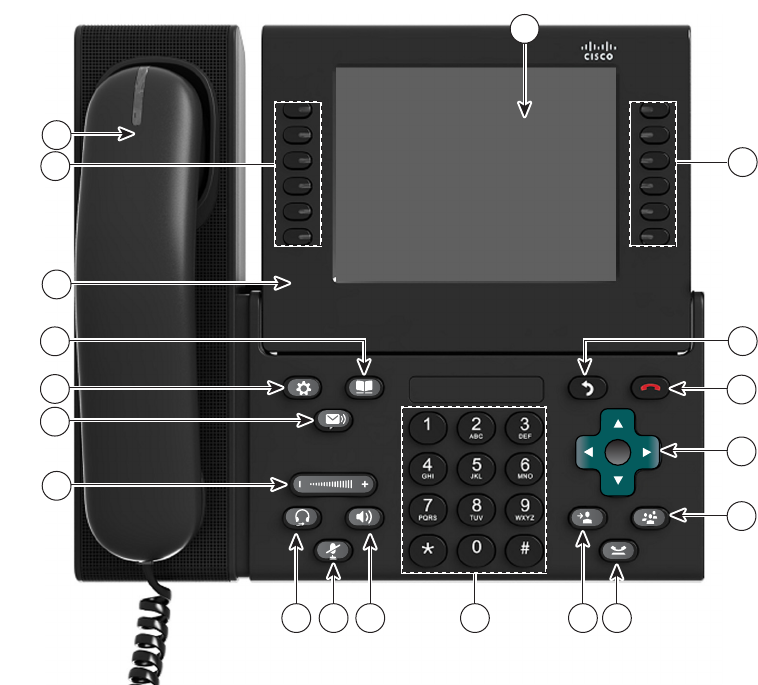
42 OL-19963-01
EFT DRAFT - CISCO CONFIDENTIAL
1
711 1012 9 8
13
17
19
18
14
15
16
4
5
6
3
2
194675
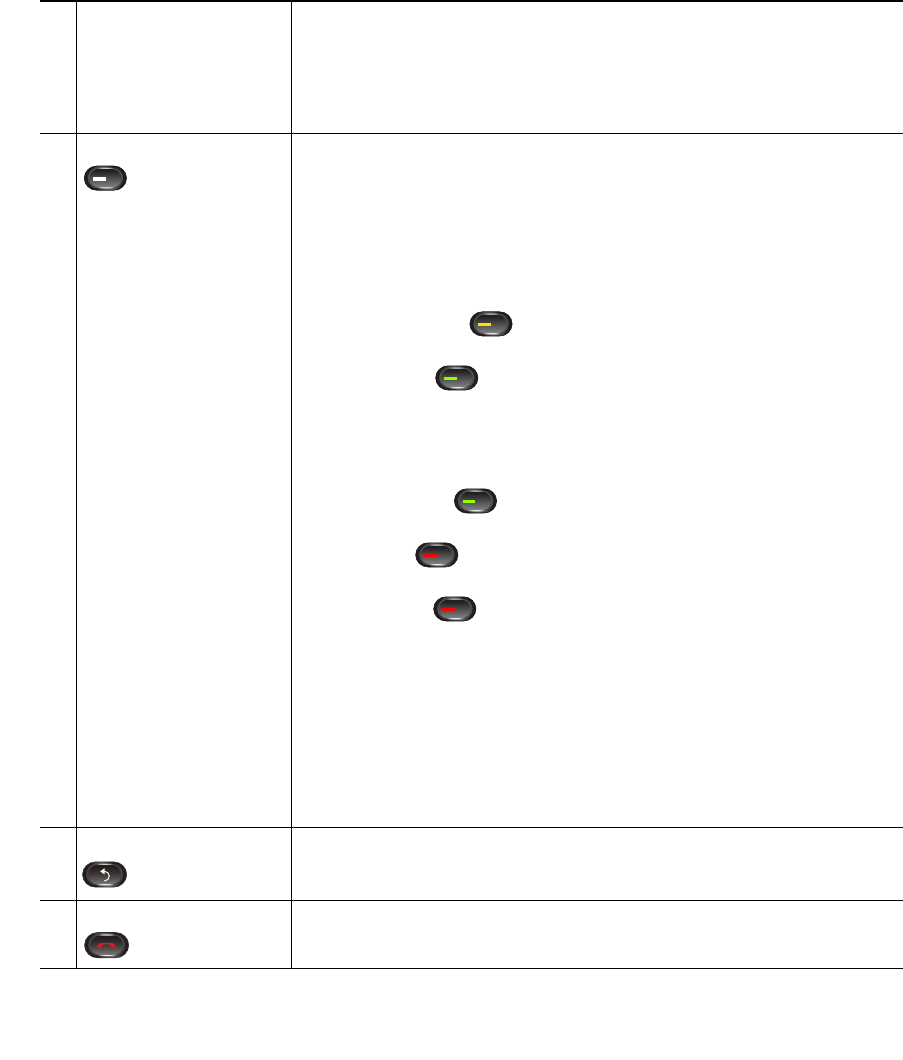
Your Phone
Cisco Unified IP Phone 8961, 9951, and 9971 User Guide for Cisco Unified Communications Manager 7.1(3) (SIP) 43
EFT DRAFT - CISCO CONFIDENTIAL
1Phone screen Shows information about your phone, including directory number, call
information (for example caller ID, icons for an active call or call on
hold) and available softkeys.
Phone screen items, such as menu options and softkeys, are
touch-sensitive.
2Session buttons Each represents a call session and takes the default action for that
session. For example, pressing the session button for a ringing call
answers the call, while pressing the session button for a held call
resumes the call.
Color LEDs reflect the call state. LEDs can flash (blink on and off
rapidly), pulse (alternately dim and brighten), or appear solid (glow
without interruption).
• Flashing amber —Ringing call. Pressing this button answers
the call.
• Solid green —May be a connected call or an outgoing call
that is not yet connected. If the call is connected, pressing this
button displays the call details or the participants of a conference
call. If the call is not yet connected, pressing this button ends the
call.
• Pulsing green —Held call. Pressing this button resumes the
held call.
• Solid red —Shared line in-use remotely. Pressing this button
allows you to barge in on the call (if Barge is enabled).
• Pulsing red —Shared line call put on hold remotely. Pressing
this button resumes the held call.
Icons next to the session buttons indicate an action for that session. For
example, pressing the session button with a Missed Calls icon displays
your missed calls, and pressing the session button with a Voicemail
icon accesses your voice messaging system.
(The position of session buttons may be reversed with that of
programmable feature buttons on phones using a locale with a
right-to-left reading orientation, such as Hebrew and Arabic.)
3Back button Returns to the previous screen or menu.
4Release button Ends a connected call or session.